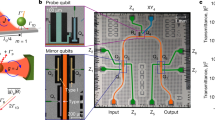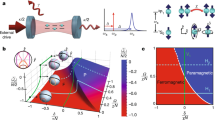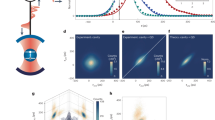Abstract
Conventional lasers (from table-top systems to microscopic devices) typically operate in the so-called weak-coupling regime, involving large numbers of atoms and photons; individual quanta have a negligible impact on the system dynamics. However, this is no longer the case when the system approaches the regime of strong coupling for which the number of atoms and photons can become quite small. Indeed, the lasing properties of a single atom in a resonant cavity have been extensively investigated theoretically1,2,3,4,5,6,7,8,9,10,11. Here we report the experimental realization of a one-atom laser operated in the regime of strong coupling. We exploit recent advances12 in cavity quantum electrodynamics that allow one atom to be isolated in an optical cavity in a regime for which one photon is sufficient to saturate the atomic transition. The observed characteristics of the atom–cavity system are qualitatively different from those of the familiar many-atom case. Specifically, our measurements of the intracavity photon number versus pump intensity indicate that there is no threshold for lasing, and we infer that the output flux from the cavity mode exceeds that from atomic fluorescence by more than tenfold. Observations of the second-order intensity correlation function demonstrate that our one-atom laser generates manifestly quantum (nonclassical) light, typified by photon anti-bunching and sub-poissonian photon statistics.
This is a preview of subscription content, access via your institution
Access options
Subscribe to this journal
Receive 51 print issues and online access
$199.00 per year
only $3.90 per issue
Buy this article
- Purchase on Springer Link
- Instant access to full article PDF
Prices may be subject to local taxes which are calculated during checkout




Similar content being viewed by others
References
Mu, Y. & Savage, C. M. One-atom lasers. Phys. Rev. A 46, 5944–5954 (1992)
Ginzel, C., Briegel, H.-J., Martini, U., Englert, B.-G. & Schenzle, A. Quantum optical master equations: The one-atom laser. Phys. Rev. A 48, 732–738 (1993)
Pellizzari, T. & Ritsch, H. Preparation of stationary Fock states in a one-atom Raman laser. Phys. Rev. Lett. 72, 3973–3976 (1994)
Pellizzari, T. & Ritsch, H. Photon statistics of the three-level one-atom laser. J. Mod. Opt. 41, 609–623 (1994)
Horak, P., Gheri, K. M. & Ritsch, H. Quantum dynamics of a single-atom cascade laser. Phys. Rev. A. 51, 3257–3266 (1995)
Meyer, G. M., Briegel, H.-J. & Walther, H. Ion-trap laser. Europhys. Lett. 37, 317–322 (1997)
Löffler, M., Meyer, G. M. & Walther, H. Spectral properties of the one-atom laser. Phys. Rev. A 55, 3923–3930 (1997)
Meyer, G. M., Löffler, M. & Walther, H. Spectrum of the ion-trap laser. Phys. Rev. A 56, R1099–R1102 (1997)
Meyer, G. M. & Briegel, H.-J. Pump-operator treatment of the ion-trap laser. Phys. Rev. A 58, 3210–3220 (1998)
Jones, B., Ghose, S., Clemens, J. P., Rice, P. R. & Pedrotti, L. M. Photon statistics of a single atom laser. Phys. Rev. A 60, 3267–3275 (1999)
Kilin, S. Ya. & Karlovich, T. B. Single-atom laser: Coherent and nonclassical effects in the regime of a strong atom-field correlation. JETP 95, 805–819 (2002)
McKeever, J. et al. State-insensitive cooling and trapping of single atoms in an optical cavity. Phys. Rev. Lett. 90, 133602 (2003)
Sargent, M. III, Scully, M. O. & Lamb, W. E. Jr Laser Physics (Addison-Wesley, Reading, MA, 1974)
Haken, H. Laser Theory (Springer, Berlin, 1984)
Mandel, L. & Wolf, E. Optical Coherence and Quantum Optics (Cambridge Univ. Press, Cambridge, 1995)
Carmichael, H. J. Statistical Methods in Quantum Optics 1 (Springer, Berlin, 1999)
Gardiner, C. W. & Zoller, P. Quantum Noise (Springer, Berlin, 2000)
Kimble, H. J. Strong interactions of single atoms and photons in cavity QED. Phys. Scr. T76, 127–137 (1998)
Raithel, G., Wagner, C., Walther, H., Narducci, L. M. & Scully, M. O. Cavity Quantum Electrodynamics (ed. Berman, P.) 57–121 (Academic, San Diego, 1994)
Haroche, S. & Raimond, J. M. Cavity Quantum Electrodynamics (ed. Berman, P.) 123–170 (Academic, San Diego, 1994)
Meystre, P. in Progress in Optics Vol. XXX (ed. Wolf, E.) 261–355 (Elsevier, Amsterdam, 1992)
An, K. & Feld, M. S. Semiclassical four-level single-atom laser. Phys. Rev. A 56, 1662–1665 (1997)
Chang, R. K. & Campillo, A. J. (eds) Optical Processes in Microcavities (World Scientific, Singapore, 1996)
Vahala, K. J. Optical microcavities. Nature 424, 839–846 (2003)
Ye, J., Vernooy, D. W. & Kimble, H. J. Trapping of single atoms in cavity QED. Phys. Rev. Lett. 83, 4987–4990 (1999)
Rice, P. R. & Carmichael, H. J. Photon statistics of a cavity-QED laser: A comment on the laser-phase-transition analogy. Phys. Rev. A 50, 4318–4329 (1994)
Boozer, A. D., Boca, A., Buck, J. R., McKeever, J. & Kimble, H. J. Comparison of theory and experiment for a one-atom laser in a regime of strong coupling. Phys. Rev. A (submitted); preprint available at 〈http://lanl.arxiv.org/archive/quant-ph〉
Metcalf, H. J. & van der Straten, P. Laser Cooling and Trapping (Springer, New York, 1999)
Boiron, D. et al. Laser cooling of cesium atoms in gray optical molasses down to 1.1 µK. Phys. Rev. A 53, R3734–R3737 (1996)
Corwin, K. L., Kuppens, S. J. M., Cho, D. & Wieman, C. E. Spin-polarized atoms in a circularly polarized optical dipole trap. Phys. Rev. Lett. 83, 1311–1314 (1999)
Acknowledgements
We gratefully acknowledge interactions with K. Birnbaum, C.-W. Chou, A. C. Doherty, L.-M. Duan, T. Lynn, T. Northup, S. Polyakov and D. M. Stamper-Kurn. This work was supported by the National Science Foundation, by the Caltech MURI Center for Quantum Networks, and by the Office of Naval Research.
Author information
Authors and Affiliations
Corresponding author
Ethics declarations
Competing interests
The authors declare that they have no competing financial interests.
Supplementary information
Rights and permissions
About this article
Cite this article
McKeever, J., Boca, A., Boozer, A. et al. Experimental realization of a one-atom laser in the regime of strong coupling. Nature 425, 268–271 (2003). https://doi.org/10.1038/nature01974
Received:
Accepted:
Issue Date:
DOI: https://doi.org/10.1038/nature01974
This article is cited by
-
Ultrastrong magnetic light-matter interaction with cavity mode engineering
Communications Physics (2023)
-
Active optomechanics
Communications Physics (2022)
-
An inhibited laser
Communications Physics (2022)
-
Fidelity and Entanglement in the Open Spin Chain with Markovian and Non- Markovian Dynamics
International Journal of Theoretical Physics (2022)
-
Spontaneous emission in micro- or nanophotonic structures
PhotoniX (2021)
Comments
By submitting a comment you agree to abide by our Terms and Community Guidelines. If you find something abusive or that does not comply with our terms or guidelines please flag it as inappropriate.



